Structural Functionalism: Theory, Society, and Contemporary Relevance
VerifiedAdded on 2022/09/09
|6
|1307
|29
Essay
AI Summary
This essay delves into the sociological theory of structural functionalism, tracing its origins from functionalism and the works of Herbert Spencer and Emile Durkheim. It explores how structural functionalism views society as a system where different parts work together to maintain stability, mirroring the human body's organ systems. The essay examines the theory's application in understanding social structures, particularly in urban settings, and how societal changes, such as industrialization and technological advancements, influence its evolution. It also highlights the role of social learning, education, and system needs in shaping societal behavior and the contemporary relevance of structural functionalism in analyzing the impact of technology and infrastructure on society. The essay concludes by emphasizing the theory's utility in understanding societal evolution and change.
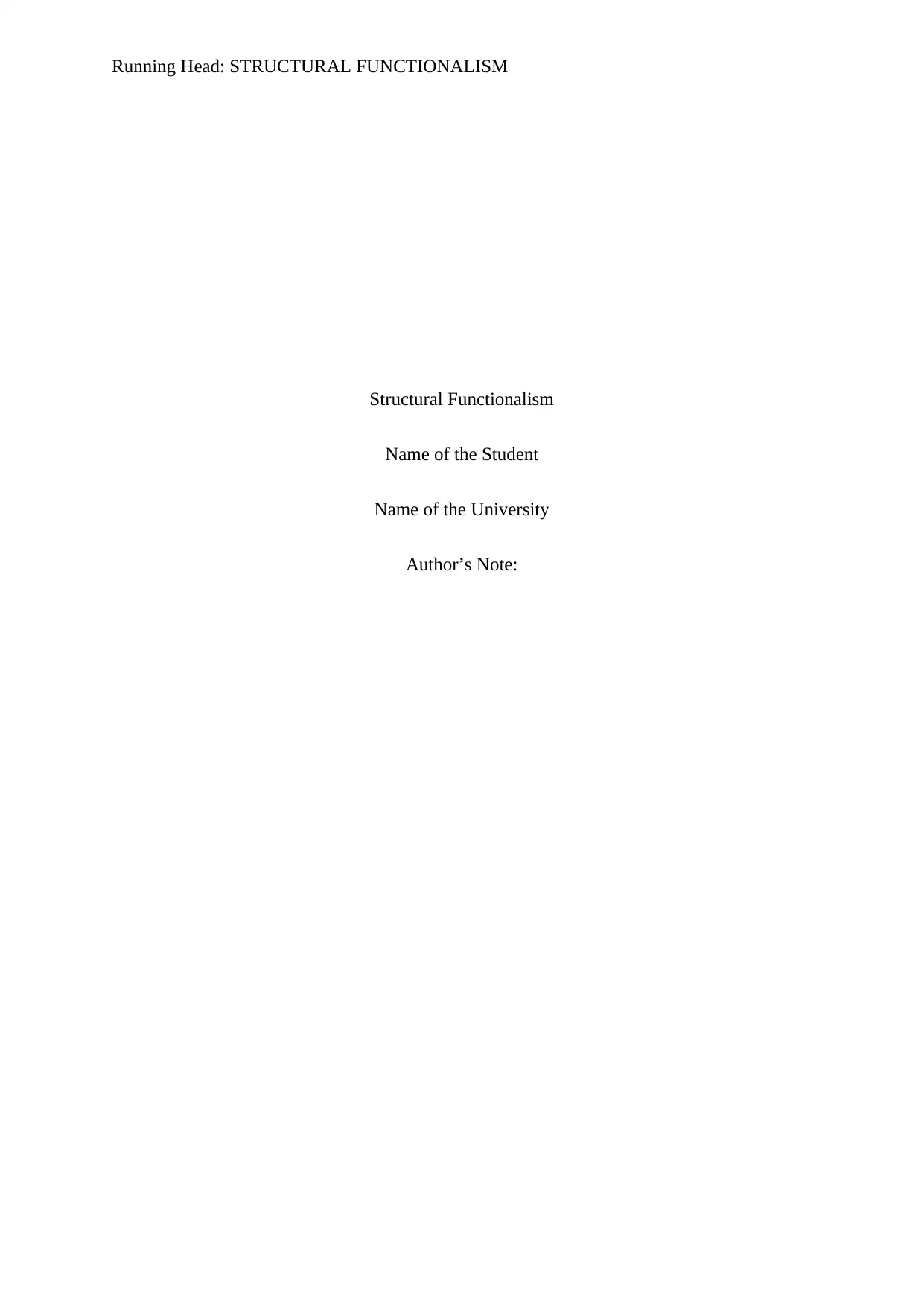
Running Head: STRUCTURAL FUNCTIONALISM
Structural Functionalism
Name of the Student
Name of the University
Author’s Note:
Structural Functionalism
Name of the Student
Name of the University
Author’s Note:
Paraphrase This Document
Need a fresh take? Get an instant paraphrase of this document with our AI Paraphraser
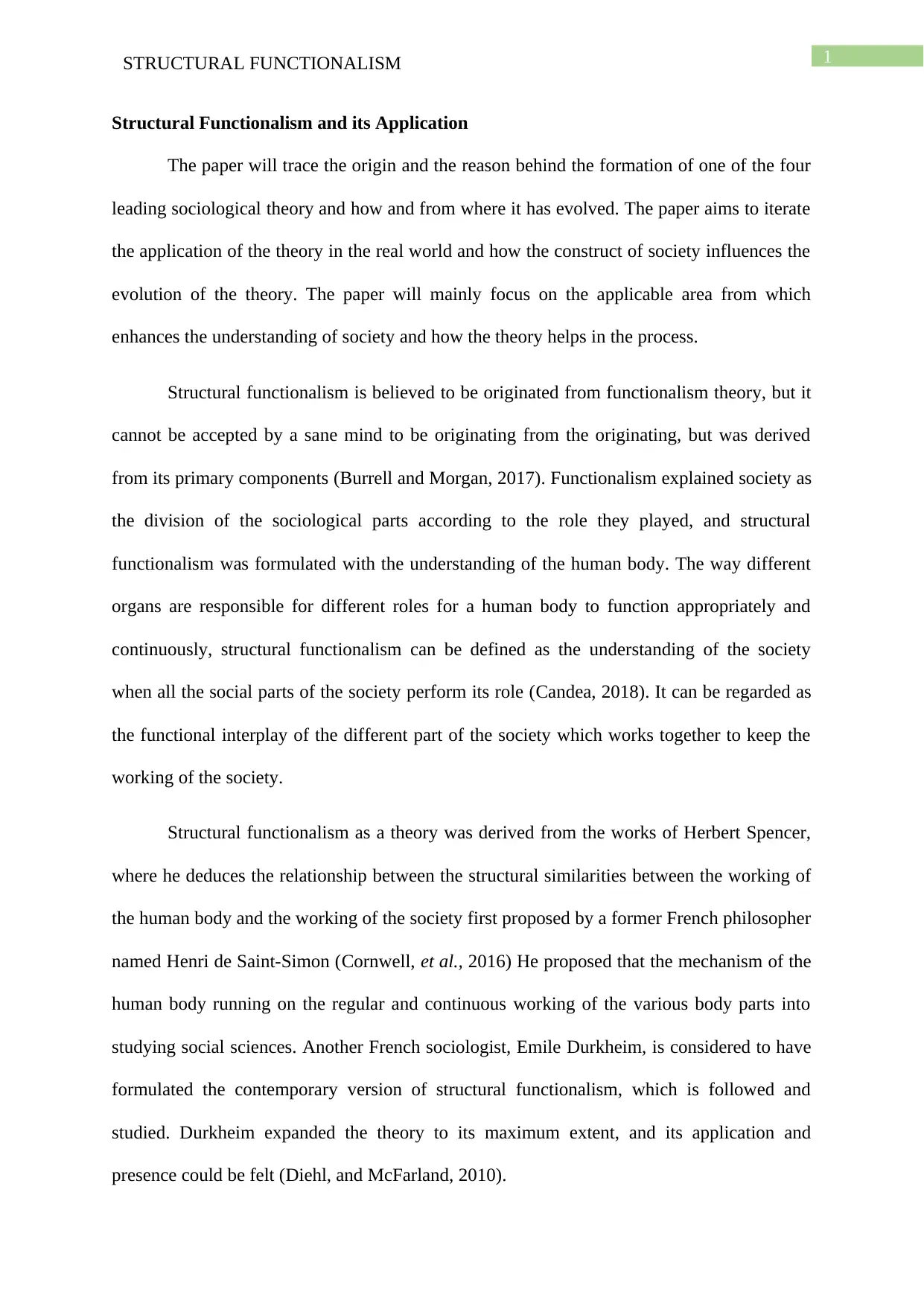
1STRUCTURAL FUNCTIONALISM
Structural Functionalism and its Application
The paper will trace the origin and the reason behind the formation of one of the four
leading sociological theory and how and from where it has evolved. The paper aims to iterate
the application of the theory in the real world and how the construct of society influences the
evolution of the theory. The paper will mainly focus on the applicable area from which
enhances the understanding of society and how the theory helps in the process.
Structural functionalism is believed to be originated from functionalism theory, but it
cannot be accepted by a sane mind to be originating from the originating, but was derived
from its primary components (Burrell and Morgan, 2017). Functionalism explained society as
the division of the sociological parts according to the role they played, and structural
functionalism was formulated with the understanding of the human body. The way different
organs are responsible for different roles for a human body to function appropriately and
continuously, structural functionalism can be defined as the understanding of the society
when all the social parts of the society perform its role (Candea, 2018). It can be regarded as
the functional interplay of the different part of the society which works together to keep the
working of the society.
Structural functionalism as a theory was derived from the works of Herbert Spencer,
where he deduces the relationship between the structural similarities between the working of
the human body and the working of the society first proposed by a former French philosopher
named Henri de Saint-Simon (Cornwell, et al., 2016) He proposed that the mechanism of the
human body running on the regular and continuous working of the various body parts into
studying social sciences. Another French sociologist, Emile Durkheim, is considered to have
formulated the contemporary version of structural functionalism, which is followed and
studied. Durkheim expanded the theory to its maximum extent, and its application and
presence could be felt (Diehl, and McFarland, 2010).
Structural Functionalism and its Application
The paper will trace the origin and the reason behind the formation of one of the four
leading sociological theory and how and from where it has evolved. The paper aims to iterate
the application of the theory in the real world and how the construct of society influences the
evolution of the theory. The paper will mainly focus on the applicable area from which
enhances the understanding of society and how the theory helps in the process.
Structural functionalism is believed to be originated from functionalism theory, but it
cannot be accepted by a sane mind to be originating from the originating, but was derived
from its primary components (Burrell and Morgan, 2017). Functionalism explained society as
the division of the sociological parts according to the role they played, and structural
functionalism was formulated with the understanding of the human body. The way different
organs are responsible for different roles for a human body to function appropriately and
continuously, structural functionalism can be defined as the understanding of the society
when all the social parts of the society perform its role (Candea, 2018). It can be regarded as
the functional interplay of the different part of the society which works together to keep the
working of the society.
Structural functionalism as a theory was derived from the works of Herbert Spencer,
where he deduces the relationship between the structural similarities between the working of
the human body and the working of the society first proposed by a former French philosopher
named Henri de Saint-Simon (Cornwell, et al., 2016) He proposed that the mechanism of the
human body running on the regular and continuous working of the various body parts into
studying social sciences. Another French sociologist, Emile Durkheim, is considered to have
formulated the contemporary version of structural functionalism, which is followed and
studied. Durkheim expanded the theory to its maximum extent, and its application and
presence could be felt (Diehl, and McFarland, 2010).
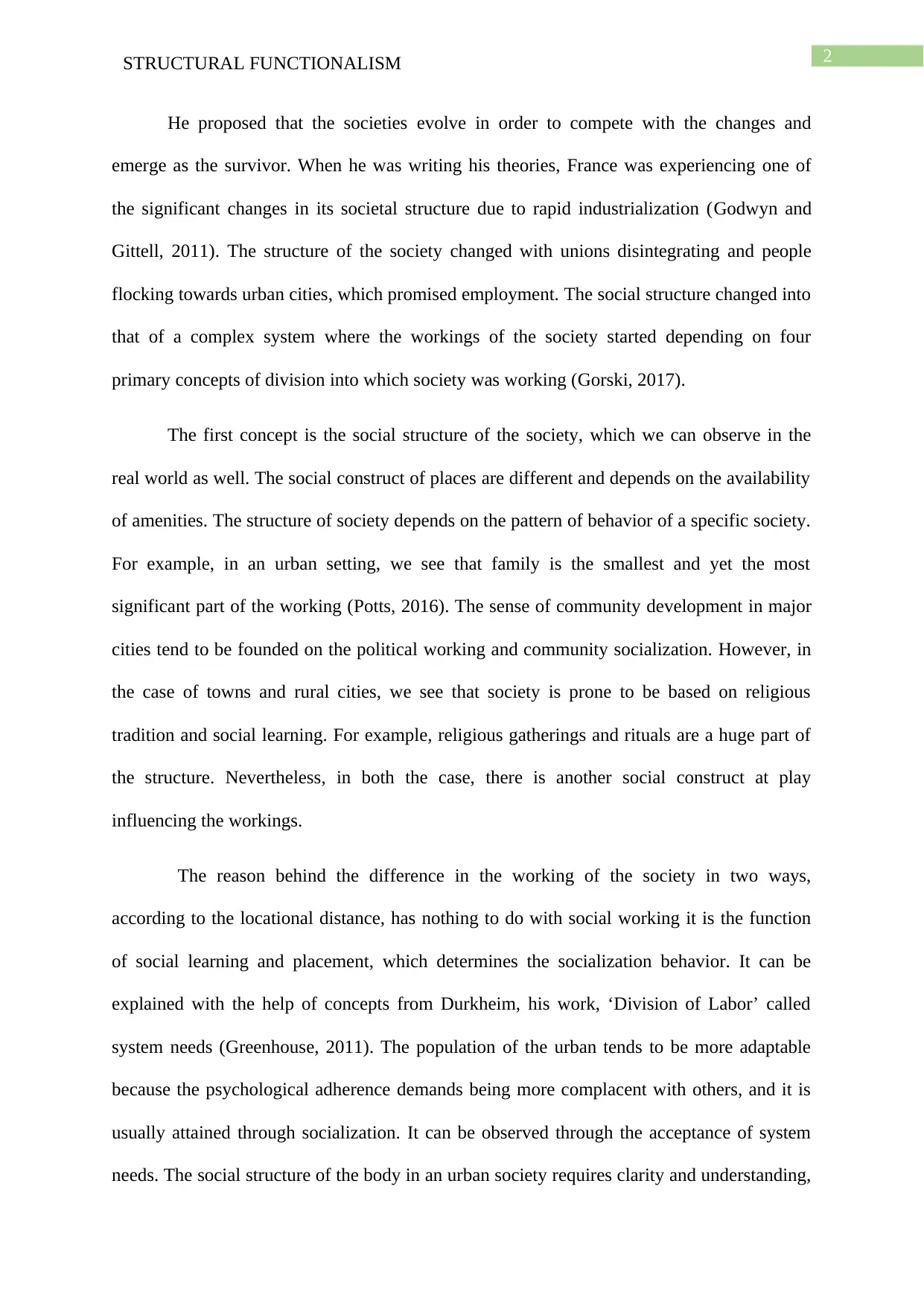
2STRUCTURAL FUNCTIONALISM
He proposed that the societies evolve in order to compete with the changes and
emerge as the survivor. When he was writing his theories, France was experiencing one of
the significant changes in its societal structure due to rapid industrialization (Godwyn and
Gittell, 2011). The structure of the society changed with unions disintegrating and people
flocking towards urban cities, which promised employment. The social structure changed into
that of a complex system where the workings of the society started depending on four
primary concepts of division into which society was working (Gorski, 2017).
The first concept is the social structure of the society, which we can observe in the
real world as well. The social construct of places are different and depends on the availability
of amenities. The structure of society depends on the pattern of behavior of a specific society.
For example, in an urban setting, we see that family is the smallest and yet the most
significant part of the working (Potts, 2016). The sense of community development in major
cities tend to be founded on the political working and community socialization. However, in
the case of towns and rural cities, we see that society is prone to be based on religious
tradition and social learning. For example, religious gatherings and rituals are a huge part of
the structure. Nevertheless, in both the case, there is another social construct at play
influencing the workings.
The reason behind the difference in the working of the society in two ways,
according to the locational distance, has nothing to do with social working it is the function
of social learning and placement, which determines the socialization behavior. It can be
explained with the help of concepts from Durkheim, his work, ‘Division of Labor’ called
system needs (Greenhouse, 2011). The population of the urban tends to be more adaptable
because the psychological adherence demands being more complacent with others, and it is
usually attained through socialization. It can be observed through the acceptance of system
needs. The social structure of the body in an urban society requires clarity and understanding,
He proposed that the societies evolve in order to compete with the changes and
emerge as the survivor. When he was writing his theories, France was experiencing one of
the significant changes in its societal structure due to rapid industrialization (Godwyn and
Gittell, 2011). The structure of the society changed with unions disintegrating and people
flocking towards urban cities, which promised employment. The social structure changed into
that of a complex system where the workings of the society started depending on four
primary concepts of division into which society was working (Gorski, 2017).
The first concept is the social structure of the society, which we can observe in the
real world as well. The social construct of places are different and depends on the availability
of amenities. The structure of society depends on the pattern of behavior of a specific society.
For example, in an urban setting, we see that family is the smallest and yet the most
significant part of the working (Potts, 2016). The sense of community development in major
cities tend to be founded on the political working and community socialization. However, in
the case of towns and rural cities, we see that society is prone to be based on religious
tradition and social learning. For example, religious gatherings and rituals are a huge part of
the structure. Nevertheless, in both the case, there is another social construct at play
influencing the workings.
The reason behind the difference in the working of the society in two ways,
according to the locational distance, has nothing to do with social working it is the function
of social learning and placement, which determines the socialization behavior. It can be
explained with the help of concepts from Durkheim, his work, ‘Division of Labor’ called
system needs (Greenhouse, 2011). The population of the urban tends to be more adaptable
because the psychological adherence demands being more complacent with others, and it is
usually attained through socialization. It can be observed through the acceptance of system
needs. The social structure of the body in an urban society requires clarity and understanding,
⊘ This is a preview!⊘
Do you want full access?
Subscribe today to unlock all pages.

Trusted by 1+ million students worldwide
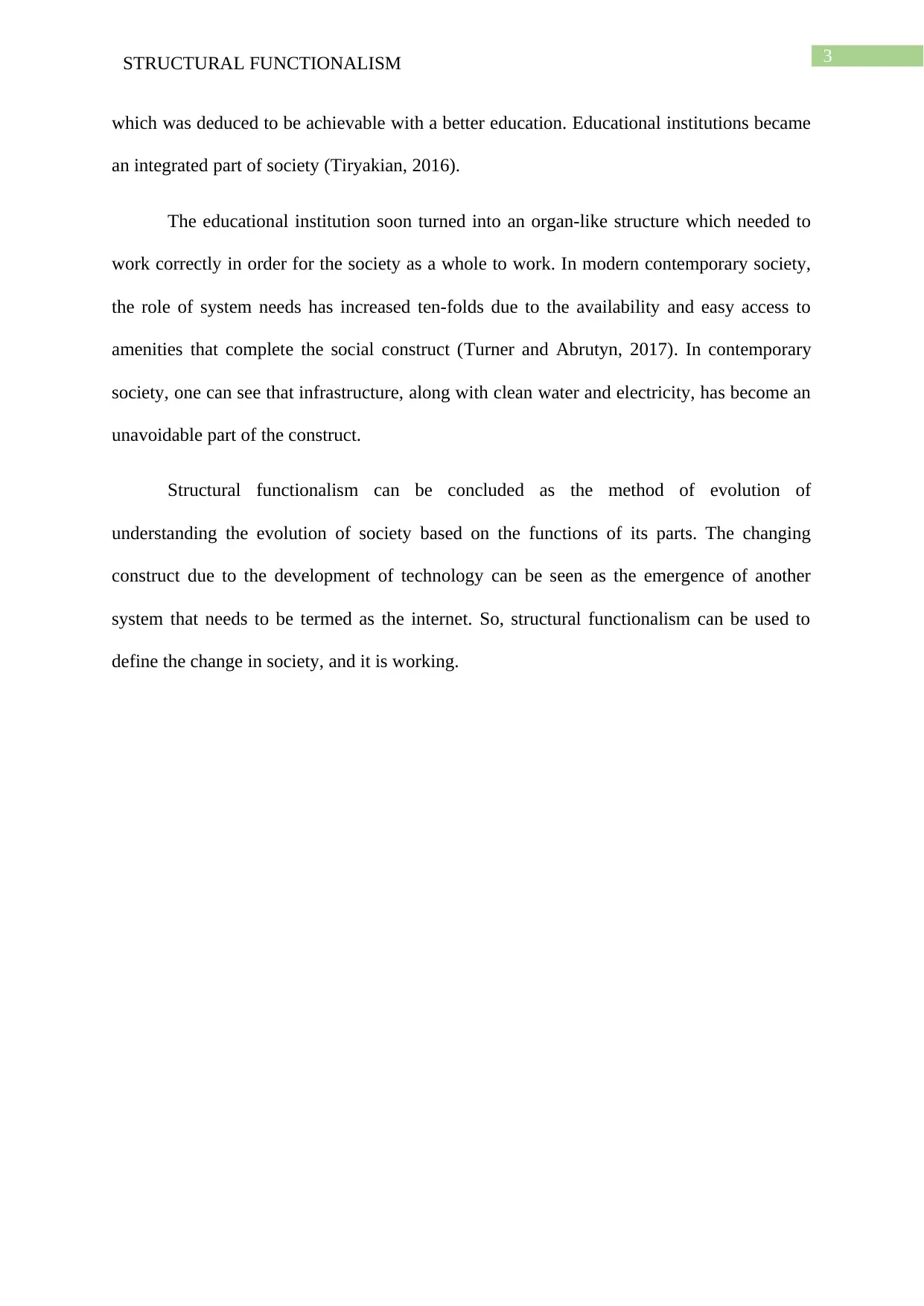
3STRUCTURAL FUNCTIONALISM
which was deduced to be achievable with a better education. Educational institutions became
an integrated part of society (Tiryakian, 2016).
The educational institution soon turned into an organ-like structure which needed to
work correctly in order for the society as a whole to work. In modern contemporary society,
the role of system needs has increased ten-folds due to the availability and easy access to
amenities that complete the social construct (Turner and Abrutyn, 2017). In contemporary
society, one can see that infrastructure, along with clean water and electricity, has become an
unavoidable part of the construct.
Structural functionalism can be concluded as the method of evolution of
understanding the evolution of society based on the functions of its parts. The changing
construct due to the development of technology can be seen as the emergence of another
system that needs to be termed as the internet. So, structural functionalism can be used to
define the change in society, and it is working.
which was deduced to be achievable with a better education. Educational institutions became
an integrated part of society (Tiryakian, 2016).
The educational institution soon turned into an organ-like structure which needed to
work correctly in order for the society as a whole to work. In modern contemporary society,
the role of system needs has increased ten-folds due to the availability and easy access to
amenities that complete the social construct (Turner and Abrutyn, 2017). In contemporary
society, one can see that infrastructure, along with clean water and electricity, has become an
unavoidable part of the construct.
Structural functionalism can be concluded as the method of evolution of
understanding the evolution of society based on the functions of its parts. The changing
construct due to the development of technology can be seen as the emergence of another
system that needs to be termed as the internet. So, structural functionalism can be used to
define the change in society, and it is working.
Paraphrase This Document
Need a fresh take? Get an instant paraphrase of this document with our AI Paraphraser
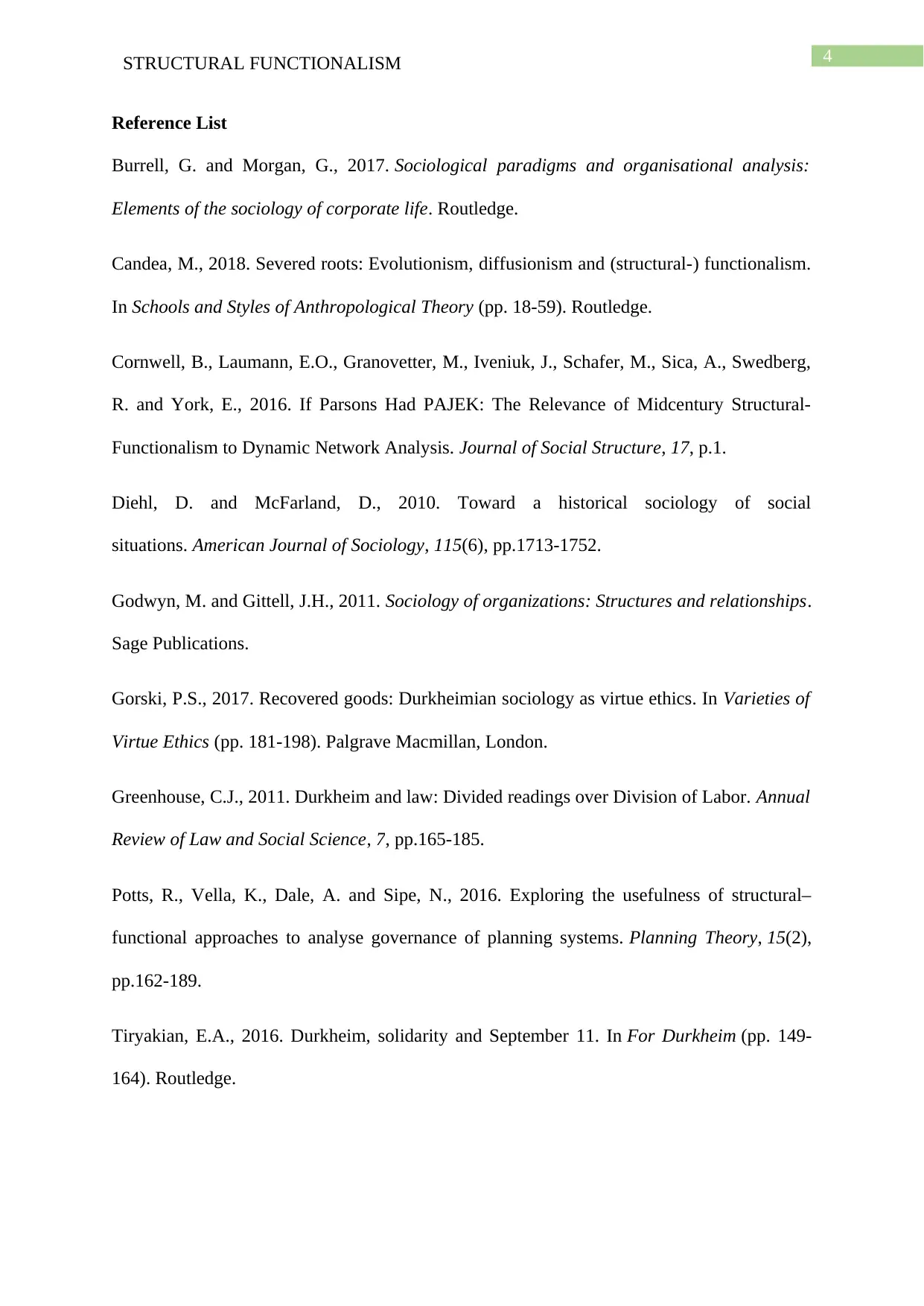
4STRUCTURAL FUNCTIONALISM
Reference List
Burrell, G. and Morgan, G., 2017. Sociological paradigms and organisational analysis:
Elements of the sociology of corporate life. Routledge.
Candea, M., 2018. Severed roots: Evolutionism, diffusionism and (structural-) functionalism.
In Schools and Styles of Anthropological Theory (pp. 18-59). Routledge.
Cornwell, B., Laumann, E.O., Granovetter, M., Iveniuk, J., Schafer, M., Sica, A., Swedberg,
R. and York, E., 2016. If Parsons Had PAJEK: The Relevance of Midcentury Structural-
Functionalism to Dynamic Network Analysis. Journal of Social Structure, 17, p.1.
Diehl, D. and McFarland, D., 2010. Toward a historical sociology of social
situations. American Journal of Sociology, 115(6), pp.1713-1752.
Godwyn, M. and Gittell, J.H., 2011. Sociology of organizations: Structures and relationships.
Sage Publications.
Gorski, P.S., 2017. Recovered goods: Durkheimian sociology as virtue ethics. In Varieties of
Virtue Ethics (pp. 181-198). Palgrave Macmillan, London.
Greenhouse, C.J., 2011. Durkheim and law: Divided readings over Division of Labor. Annual
Review of Law and Social Science, 7, pp.165-185.
Potts, R., Vella, K., Dale, A. and Sipe, N., 2016. Exploring the usefulness of structural–
functional approaches to analyse governance of planning systems. Planning Theory, 15(2),
pp.162-189.
Tiryakian, E.A., 2016. Durkheim, solidarity and September 11. In For Durkheim (pp. 149-
164). Routledge.
Reference List
Burrell, G. and Morgan, G., 2017. Sociological paradigms and organisational analysis:
Elements of the sociology of corporate life. Routledge.
Candea, M., 2018. Severed roots: Evolutionism, diffusionism and (structural-) functionalism.
In Schools and Styles of Anthropological Theory (pp. 18-59). Routledge.
Cornwell, B., Laumann, E.O., Granovetter, M., Iveniuk, J., Schafer, M., Sica, A., Swedberg,
R. and York, E., 2016. If Parsons Had PAJEK: The Relevance of Midcentury Structural-
Functionalism to Dynamic Network Analysis. Journal of Social Structure, 17, p.1.
Diehl, D. and McFarland, D., 2010. Toward a historical sociology of social
situations. American Journal of Sociology, 115(6), pp.1713-1752.
Godwyn, M. and Gittell, J.H., 2011. Sociology of organizations: Structures and relationships.
Sage Publications.
Gorski, P.S., 2017. Recovered goods: Durkheimian sociology as virtue ethics. In Varieties of
Virtue Ethics (pp. 181-198). Palgrave Macmillan, London.
Greenhouse, C.J., 2011. Durkheim and law: Divided readings over Division of Labor. Annual
Review of Law and Social Science, 7, pp.165-185.
Potts, R., Vella, K., Dale, A. and Sipe, N., 2016. Exploring the usefulness of structural–
functional approaches to analyse governance of planning systems. Planning Theory, 15(2),
pp.162-189.
Tiryakian, E.A., 2016. Durkheim, solidarity and September 11. In For Durkheim (pp. 149-
164). Routledge.
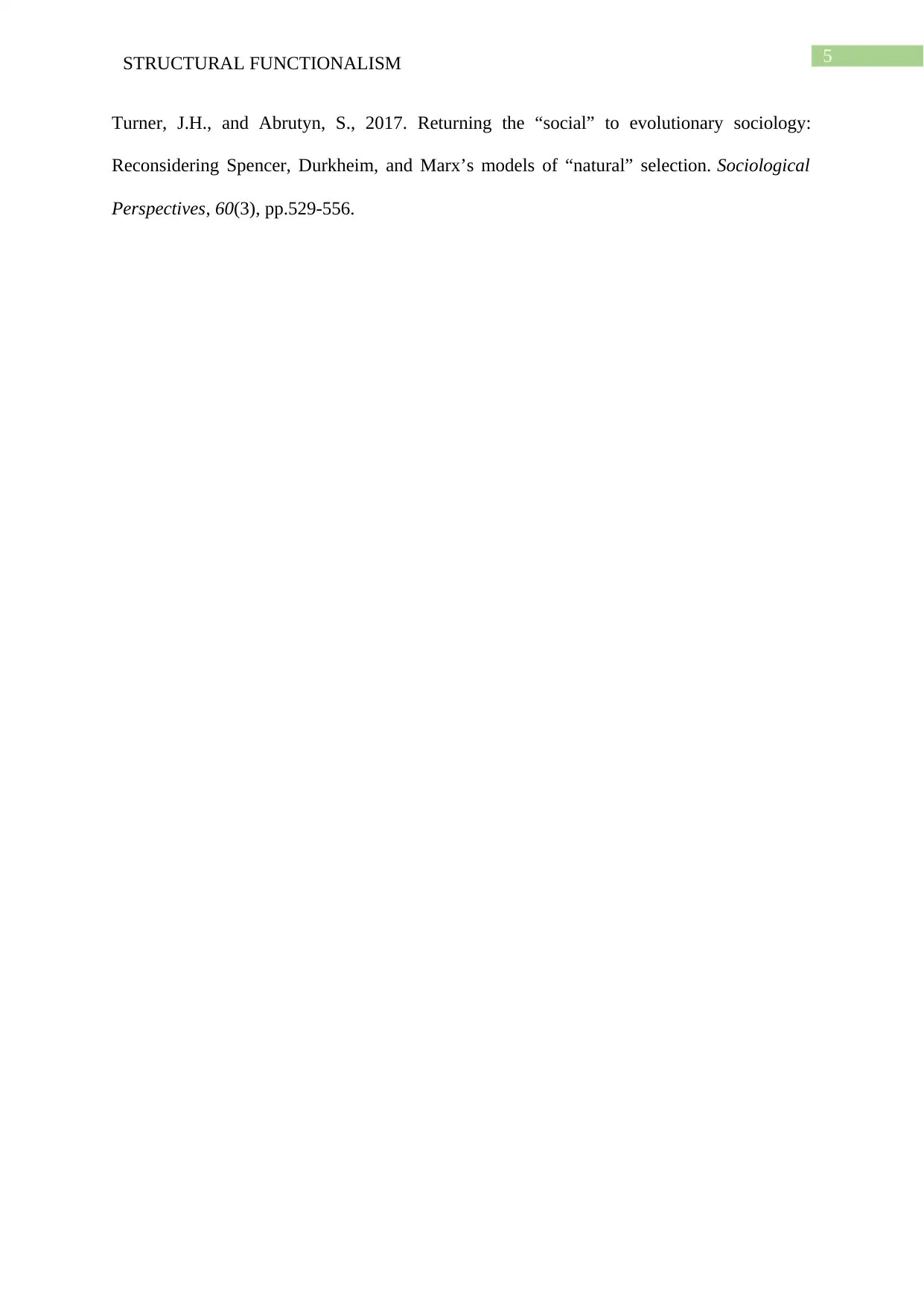
5STRUCTURAL FUNCTIONALISM
Turner, J.H., and Abrutyn, S., 2017. Returning the “social” to evolutionary sociology:
Reconsidering Spencer, Durkheim, and Marx’s models of “natural” selection. Sociological
Perspectives, 60(3), pp.529-556.
Turner, J.H., and Abrutyn, S., 2017. Returning the “social” to evolutionary sociology:
Reconsidering Spencer, Durkheim, and Marx’s models of “natural” selection. Sociological
Perspectives, 60(3), pp.529-556.
⊘ This is a preview!⊘
Do you want full access?
Subscribe today to unlock all pages.

Trusted by 1+ million students worldwide
1 out of 6
Related Documents
Your All-in-One AI-Powered Toolkit for Academic Success.
+13062052269
info@desklib.com
Available 24*7 on WhatsApp / Email
![[object Object]](/_next/static/media/star-bottom.7253800d.svg)
Unlock your academic potential
Copyright © 2020–2025 A2Z Services. All Rights Reserved. Developed and managed by ZUCOL.




